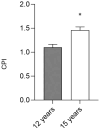Prevalence of Oral Diseases and the Influence of the Presence of Overweight/Obesity in Schoolchildren Population in Mallorca
- PMID: 39685742
- PMCID: PMC11642840
- DOI: 10.3390/jcm13237283
Prevalence of Oral Diseases and the Influence of the Presence of Overweight/Obesity in Schoolchildren Population in Mallorca
Abstract
Background: The pediatric population is one of the social groups most affected by oral pathology, and overweight and/or obesity is increasingly frequently observed. This work presents a study of the prevalence of oral disease in the school population in Mallorca and its relationship with overweight/obesity. Methods: A cross-sectional study was carried out with a sample of 718 students aged 5-6 (n = 255), 12 (n = 230) and 15 years (n = 233). The WHO criteria for diagnosing and coding examined teeth and overweight/obesity prevalence values. To explore the differences in data, the mean was analyzed using the Student's t-test or a one-way analysis of variance followed by the Bonferroni post hoc analysis. Results: Results found that students aged 15 years have a caries prevalence rate of 45.49%, higher than those aged 12 (27.39%). The presence of dental calculus in 15-year-old students is 52.8%, even higher than in 12-year-olds (30%). Students aged 6 and 12 with lower weight percentiles have fewer healthy teeth than those with higher percentiles. Conclusions: The schoolchildren have experienced a decrease in caries and an increase in periodontitis, with weight percentile potentially influencing the number of healthy teeth.
Keywords: caries; obesity; overweight; periodontal disease.
Conflict of interest statement
The authors declare no conflicts of interest.
Figures







References
-
- Franco Mejía A.J., Balseca Ibarra M.C. Enfermedad periodontal, prevalencia y factores de riesgo en niños y adolescentes. Revisión de la literatura. Recimundo. 2021;5:359–367. doi: 10.26820/recimundo/5.(3).sep.2021.359-367. - DOI
-
- Rodríguez Michel M., Ibañez Y., López Jordi M., Álvarez Loureiro L. Asociación entre obesidad y caries dental en niños y adolescentes. Revisión. Odontoestomatologia. 2023;25 doi: 10.22592/ode2023n41e325. - DOI
LinkOut - more resources
Full Text Sources

